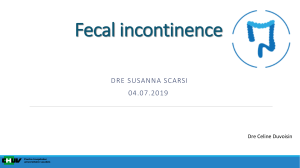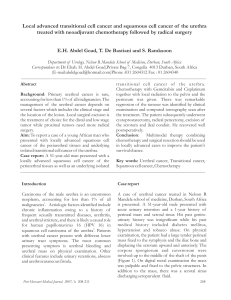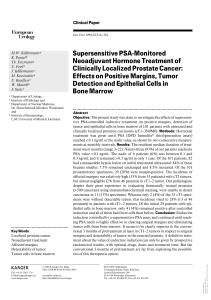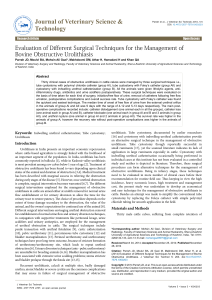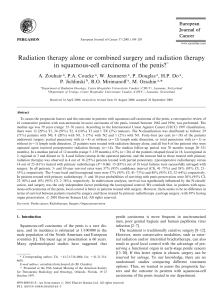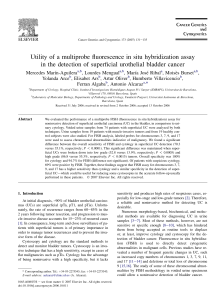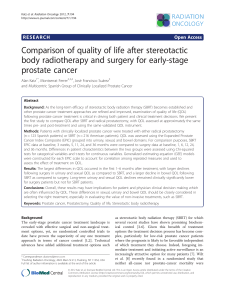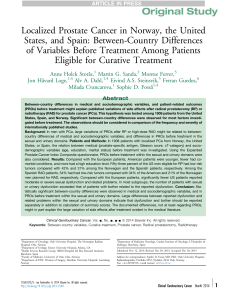http://hal.inria.fr/docs/00/76/66/12/PDF/5_mktextaw.pdf
publicité
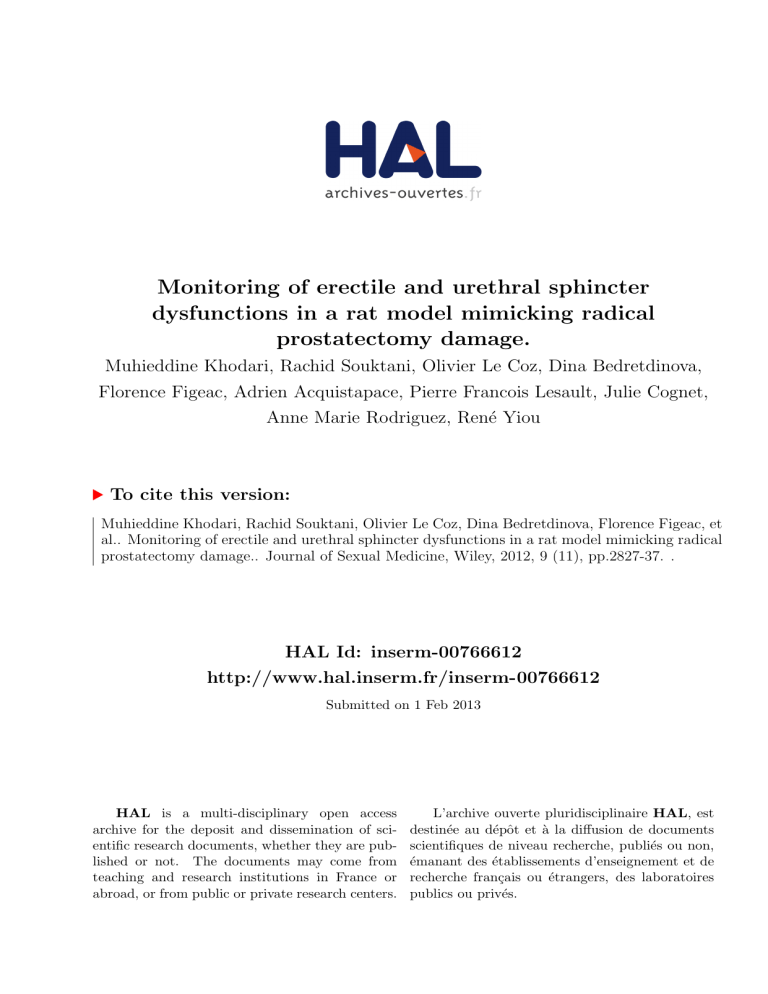
Monitoring of erectile and urethral sphincter dysfunctions in a rat model mimicking radical prostatectomy damage. Muhieddine Khodari, Rachid Souktani, Olivier Le Coz, Dina Bedretdinova, Florence Figeac, Adrien Acquistapace, Pierre Francois Lesault, Julie Cognet, Anne Marie Rodriguez, René Yiou To cite this version: Muhieddine Khodari, Rachid Souktani, Olivier Le Coz, Dina Bedretdinova, Florence Figeac, et al.. Monitoring of erectile and urethral sphincter dysfunctions in a rat model mimicking radical prostatectomy damage.. Journal of Sexual Medicine, Wiley, 2012, 9 (11), pp.2827-37. . HAL Id: inserm-00766612 http://www.hal.inserm.fr/inserm-00766612 Submitted on 1 Feb 2013 HAL is a multi-disciplinary open access archive for the deposit and dissemination of scientific research documents, whether they are published or not. The documents may come from teaching and research institutions in France or abroad, or from public or private research centers. L’archive ouverte pluridisciplinaire HAL, est destinée au dépôt et à la diffusion de documents scientifiques de niveau recherche, publiés ou non, émanant des établissements d’enseignement et de recherche français ou étrangers, des laboratoires publics ou privés. Monitoring of Erectile and Urethral Sphincter Dysfunctions in a Rat Model Mimicking Radical Prostatectomy Damage Muhieddine Khodari a,b,c, Rachid Souktani b,c , Olivier Le Coz b,c, Dina Bedretdinova b,c, Florence Figeac b,c, Adrien Acquistapace b,c, Pierre Francois Lesault b,c, Julie Cognet b,c, Anne Marie Rodriguez b,c*, René Yiou a,b,c* a APHP, Hospital Henri Mondor, Urology Department, Créteil, 94000, France b INSERM, U955, Créteil, 94000, France c Université Paris Est, Faculté de Médecine, Créteil, 94000, France * Correspondence: 1) Prof. René Yiou, MD, PhD, Urology Department, Henri Mondor Teaching Hospital, 51 av du Maréchal de Lattre de Tassigny, 94010 Créteil, France Tel: +33 149 812 553; Fax: +33 149 812 552 E-mail: [email protected] 2) Anne-Marie Rodriguez PhD, INSERM, Unité 955, 8 rue du Général Sarrail, Créteil, F94010 France. Telephone: +33-1-49-81-37-31. Fax: +33-1-49-81-36-42. E-mail: [email protected]. 1 Keywords: erectile dysfunction, urinary incontinence, radical prostatectomy, retrograde leak point pressure, arterial penile laser Doppler flow, durometry, apomorphine, post prostate cancer impairments Word count Word count, body of text: 3224 Abstract: 294 Figures: 6 Table: 1 References: 48 Take home message Electrocautery of the striated urethral sphincter caused severe and lasting impairment of erectile and urethral sphincter functions that could be monitored repeatedly using minimally invasive methods. Abbreviations: EF: erectile function RP: radical prostatectomy SUS: striated urethral sphincter USF: urethral sphincter function 2 ABSTRACT Introduction: Animal models of urinary incontinence and erectile dysfunction following radical prostatectomy (RP) are lacking. Aims: To develop an animal model of combined post-RP urethral sphincter and erectile dysfunctions, and non-invasive methods to assess erectile function (EF) and urinary sphincter function (USF) during prolonged follow-up. Methods: In the main experiments, 60 male Sprague Dawley rats were randomized to a sham operation (n=30) or electrocautery of both sides of the striated urethral sphincter (n=30). EF and USF were evaluated preoperatively and on postoperative days 7, 15, 30, 60 and 90. Sphincter and penile tissue samples were evaluated histologically on days 7 (n=10) and 30 (n=10) to detect apoptosis (TUNEL assays) and fibrosis (Trichrome Masson staining). Main outcome measures: To assess EF, we measured systemic and penile blood flow using penile laser Doppler and penile rigidity using a durometer before and after apomorphine injection. USF was assessed based on the retrograde leak point pressure (LPPr). Results: Apomorphine increased baseline Doppler flow by 180% (95%CI, 156%-202%) and penile hardness from 3.49±0.5 to 7.16±0.82 Shore A units but did not change systemic arterial flow. Mean LPPr was 76.8±6.18 mmHg at baseline and decreased by 50% after injury, with no response to apomorphine on day 7. EF and USF impairments persisted up to 90 days post injury. Histology showed penile apoptosis on day 7 and extensive urethral sphincter and penile fibrosis on day 30. Our data did not allow us to determine whether the impairment in erectile response to apomorphine preponderantly reflected arterial penile insufficiency or veno-occlusive dysfunction. 3 Conclusion: Electrocautery of the striated urethral sphincter caused severe and lasting impairment of EF and USF that could be monitored repeatedly using minimally invasive methods. This new animal model may hold potential for developing new treatments designed to correct post-RP impairments. 4 INTRODUCTION Radical prostatectomy (RP), the reference treatment for organ-confined prostate cancer, continues to cause erectile dysfunction and urinary incontinence despite improvements in the surgical technique [1, 2]. These impairments can severely impact quality of life [3, 4]. Post-RP impotence and urinary incontinence constitute a complex bifocal dysfunction resulting from a surgical injury. Post-RP erectile dysfunction results from injury to either the cavernous nerves [5] or the accessory pudendal arteries [6]. There is growing evidence that massive apoptosis of corporeal cells after RP plays a key role in the pathophysiology of postRP erectile dysfunction [7, 8]. Urinary incontinence is chiefly related to direct damage to the striated urethral sphincter (SUS) [9] or its nerve supply [10]. At present, there are no animal models replicating post-RP injuries and allowing monitoring of both urethral sphincter function (USF) and erectile function (EF) over time. This absence of models impedes the development of novel therapeutic strategies. Recently, cell-based treatment strategies were developed to repair post-RP damage to the penile or sphincter cells. For instance, adipose-derived stem cells were successfully used to treat animal models of either urinary incontinence [11] or erectile dysfunction [12, 13]. However, these models only partially replicated the clinical situation, as most patients with post-RP urinary incontinence also have erectile dysfunction. Therefore, the development of new regenerative treatments for post-RP impairments would benefit from an animal model allowing assessments of both USF and EF. Another limitation in earlier studies is the invasiveness of the functional methods used to evaluate USF or EF [8, 14-16]. The repeated use of these methods during longitudinal studies may induce additional damage and cause histopathological artifacts. Thus, the 5 existing animal models are not suitable for longitudinal studies requiring multiple assessments in each animal. Our objective here was to develop an improved animal model for investigating treatments for post-RP impairments such as cell-based strategies. We developed a rat model replicating the sphincter and erectile dysfunctions seen after RP and non-invasive methods allowing repeated measures of EF and USF in the same animal. 6 MATERIALS AND METHODS Animals All experiments were performed on 70 adult 6-week-old male Sprague Dawley rats according to institutional guidelines for animal care. The research protocol was approved by the local ethics committee (agreement number A-94028-245). All surgeries were performed under general anesthesia with isoflurane gas (Baxter, France) inhalation (2.5% in 500 mL/min of air). Experimental design Preliminary experiments In a first set of experiments (n=10), we sought to develop a non-invasive method for assessing USF. The reference method in rats is measurement of the antegrade leak point pressure (LPPa) [14, 17, 18] defined as the lowest bladder pressure at which urine leakage occurs through the urethral meatus in the absence of detrusor contraction. LPPa corresponds to the maximal bladder capacity. In rats, LPPa measurement is an invasive procedure requiring surgical catheter insertion. Retrograde LLP (LPPr) has been measured in humans after RP [19] and in female rats [17] as the intraurethral pressure required to open the urethral sphincter during retrograde infusion of the distal urethra. This non-invasive method has not been investigated in male rats. In preliminary experiments, we measured LPPr in male rats as described below and we compared the LPPa and LPPr profiles. The aim was to determine whether LPPr could be used alone to study USF. 7 Main experiments Next, we investigated EF and USF after an injury replicating the effects of RP. We randomly allocated 60 rats to either a sham procedure (n=30) or bilateral electrocautery of both sides of the SUS (n=30). USF and EF were evaluated at baseline and on postoperative days 7, 15, 30, 60, and 90 using LPPr measurement. Rats in the sham-operated and injury group were sacrificed on either day 7 (n=10 including 5 sham operated and 5 injured rats) or day 30 (n=10) post-injury, after USF and EF assessments. The penises and urethras were harvested from each animal for histological analysis. Electrocautery-induced cell damage was evaluated by assessing apoptosis and fibrosis at both time points. All remaining rats were sacrificed on day 90 after the last functional evaluation. Surgical procedures A lower-abdominal midline incision was made and the SUS was approached under an operating microscope (Figure 1A). In the sham group, the incision was then closed. In the injury group, an electrocautery was applied using a surgical electrical blade connected to a electrosurgical unit (Erbotom T71, Erbe), for 1 second (50 W, 600 Hz, intensity 7) at each of four points along the SUS (Figure 1B). The cavernous nerves emerge from the lower part of the pelvic plexus and run in contact with the lateral side of the SUS, accompanied with penile blood vessels. Each electrocautery point was also applied on the penile neurovascular supply. Thus, the experimental injury caused bilateral damage to the SUS and penile neurovascular supply. The abdominal incision was then sutured. 8 Assessment of USF In preliminary experiments, we investigated LPPa and LPPr in 10 male rats. The mean of four LPPa and LPPr measurements was computed for each animal as follows. A polyethylene catheter (PE20 Phymep, France) was inserted 0.5 cm into the distal urethra via the urethral meatus. The catheter was connected via a Statham pressure transducer amplifier [20] to a data acquisition board (Notochord Systems, France) and to a programmable infusion pump (Harvard Apparatus, Holliston, MA, USA). A 4-0 polyglactin suture was used to produce a watertight closure of the urethral meatus around the catheter. This catheter served to measure urethral pressure and retrograde bladder filling. The bladder was filled until it became palpable. A second supra-pubic polyethylene catheter (PE50) was then inserted transcutaneously into the bladder (Figure 1C) to measure bladder volume and pressure. The bladder was emptied through the supra-pubic catheter, and saline was infused at a constant rate. LPPa was defined as the bladder pressure when the first drop of urine appeared at the urethral meatus. Next, we studied the pressure profile corresponding to urethral sphincter opening during retrograde infusion. The bladder was filled to half its maximum capacity using the bladder catheter. Laparotomy was performed to expose the bladder. Saline mixed with methylene blue was infused through the urethral catheter, and urethral pressure was recorded continuously. LPPr was defined as the urethral pressure when methylene blue appeared in the bladder (Figure 1D). After the first LPPr measurement, the bladder was emptied and three further measurements were performed. In each animal, we compared the profiles of four successive LPPr and LPPa values using a filling flow of 200 µL/min for each measurement. 9 Assessment of EF To assess EF, apomorphine (Sigma Aldrich, France) was injected subcutaneously (0.05 mg/Kg). Apomorphine is a dopamine agonist, which can create a sexual impulse similar to psychological erection by activating the dopamine receptors in the central nervous system. Apomorphine-induced erection is primarily mediated via the sacral parasympathetic nerve system and the thoracolumbar sympathetic pathway[21]. Pharmacologically induced erections were monitored using two methods, laser Doppler and durometry, as follows. Laser Doppler was performed to investigate erythrocyte movements due to arterial flow in the cavernous sinus (Figure 1 E), as previously described [22]. Briefly, the laser Doppler surface probe (Probe 411, Perimed, France) was maintained at the base of the penis after pulling back the foreskin using a micromanipulator. The probe is designed to assess erythrocyte movement at a depth of 1 mm. Concomitantly, a second laser Doppler probe (Probe 404, Perimed) was placed on the tail of the rat to monitor the effect of apomorphine injection on systemic arterial flow. Both probes were connected to the same transducer amplifier and data acquisition board (Periflux System 5000, Perimed). Results were reported as Perfusion Units. Apomorphine-induced erections were also investigated using the Shore hardness measurement method consisting in measuring resistance to penetration of a tip. We used a durometer with a needle-shaped indenter (Digital Durometer Shore A, Mitutoyo America Corporation, Chicago, IL, USA) previously used for measuring the hardness of living tissues such as the skin [23-25] or penile prostheses [26] (Figure 1F). The force applied can range from 0 to 100 on the Shore scale indicated on the device, i.e., from 55 g to 855 g. When the indenter is pressed to the surface of the specimen, the balance between the resistance force 10 of the specimen (reflecting hardness) and the force of a spring in the tester governs the depth of the indentation. Laser Doppler and durometry were performed before and after apomorphine injection and the results were expressed as the variations in laser Doppler flow percentage and durometry, respectively. Histological analysis Penis and sphincter tissue samples were included in Tissue Tek (Thermo Scientific, France) and snap-frozen in isopentane precooled with liquid nitrogen. To visualize the extent of fibrosis, serial cryo-sections (8 µm in thickness) of sphincters and penises were stained with Masson’s Trichrome to identify collagen in blue, as previously reported [27, 28]. Apoptotic cells were detected in sphincters and penises using the TUNEL assay (Roche, France), which ensures enzymatic labeling of DNA strand breaks generated during apoptosis. Statistical Analysis GraphPad Prism (Version 5.00, USA) was used to perform the statistical analyses. The Kolmogorov-Smirnov test (with the Dallal-Wilkinson-Lilliefor P value) and Shapiro-Wilk normality test were performed to check the distribution of values. Values of LPPr, LPPa, and unit Shore A durometer hardness were normally distributed and were therefore described as mean±SD. Values of penile laser Doppler flow percentage variation were not normally distributed and were therefore described as the median with the 95% confidence interval (95% CI). P values less than 0.05 were considered statistically significant. Overall betweengroup comparisons were performed using analysis of variance (two-way ANOVA) with repeated measures by columns. 11 RESULTS First set of experiments Filling the bladder through the suprapubic catheter increased bladder pressure to a plateau corresponding to the maximal bladder capacity (Figure 2) and coinciding with urine leakage at the urethral meatus (LPPa). Retrograde bladder filling resulted in a rapid increase in the intraurethral pressure to a plateau phase that consistently coincided with the appearance of methylene blue in the bladder and was therefore taken as the LPPr. Using a flow perfusion rate of 200 µL/min, we found similar values of LPPa (78±7.1 mmHg) and LPPr (76±8.9 mmHg) and similar profiles in all 10 rats (Figure 2). These findings validated the use of LPPr alone in the main experiments to assess the effect of electrocautery on USF. Second set of experiments Electrocautery caused alterations in both EF and USF that persisted throughout the 3 months of the study. - Erectile function (Figures 3 and 4) In all the rats tested, apomorphine effects became detectable 3 minutes after the injection and lasted 30 minutes (Figure 3). Median variation in baseline arterial penile laser Doppler flow induced by apomorphine injection was +180% (95%CI, 156%-202%) overall, with no significant difference between sham rats (+174%; 95%CI, 149%-217%) and injured rats (+192%; 95%CI, 139%-209%; P>0.05). Apomorphine injection increased the mean baseline durometry value from 3.49±0.5 to 7.16±0.82 Shore A units overall, with no significant difference between sham rats (3.71±0.31) and injured rats (3.63± 0.27, P>0.05). 12 After electrocautery injury, significant declines occurred in the apomorphine-induced variations in arterial penile flow (p<0.05) and durometry values (p<0.01) and persisted throughout the 3-month study period (figure 4 and table 1). At the end of the study, no significant recovery of EF parameters was noted. Peripheral arterial flow recorded at the surface of the tail (systemic arterial flow) was not significantly modified by apomorphine injection in any of the groups or at any of the time points (p>0.05). -Urethral sphincter function Mean baseline LPPr was 76.8±6.18 mmHg overall, with no significant difference between the sham group (76.87±6.89) and the injured group (76.80±5.6, P>0.05). Electrocautery injury significantly decreased LPPr, by nearly 50% (Figure 5 and table 1). LPPr values remained unchanged in the sham group, with no significant differences across days 7, 15, 30, 60, and 90 (P>0.05). -Histological analysis (Figure 6) Electrocautery injury caused lasting loss of sphincter myofibers. Compared to sham animals, animals 30 days post-injury exhibited significant fibrosis replacing the sphincter myofibers, as assessed by Masson trichrome staining (Figures 6A and 6B). TUNEL assays showed numerous apoptotic cells throughout the corpus cavernosum 7 days after electrocautery; no apoptotic cells were found in the sham animals (Figures 6C6D). In addition, penile fibrosis was seen 30 days post-injury (Figures 6E-6F). TUNEL assays were also performed on sphincter sections 7 and 30 days post-injury. However, as nearly all the myofibers and other cells were destroyed immediately after 13 electrocautery, very few apoptotic bodies were detectable 7 and 30 days later (data not shown). 14 DISCUSSION We developed a male rat injury model replicating the two main functional impairments seen after RP, i.e., erectile dysfunction and urethral sphincter insufficiency. We also described non-invasive methods allowing repeated measurements of both EF and USF over time in the same animal. Electrocautery of the lateral aspects of the SUS resulted in lasting USF impairment with LPPr decreases that persisted up to 3 months post-injury. Histological studies showed loss of sphincter myofibers, fibrosis, and no evidence of regeneration. We previously showed that SUS electrocautery in male rats also destroyed the sphincteric nerves [14, 29]. Several hypotheses have been put forward to explain post-RP stress urinary incontinence. including i) direct damage to the urinary sphincter [30, 31]; ii) damage to its innervation [32]; and iii) a decrease in functional urethral length [33]. Direct damage to the sphincter has been hypothesized to result from accidental electrocoagulation during hemostasis of the dorsal vein complex [30] or sphincter transection [31]. To our knowledge, no prior studies have documented the exact nature of histopathological changes in the SUS after RP. MRI studies in patients with post-RP stress urinary incontinence showed evidence of periurethral fibrosis that probably involved the SUS [33]. In females with intrinsic sphincter insufficiency, histopathological studies also revealed fibrosis associated with loss of sphincter myofibers [34], as observed in our model. Electrocautery also caused dramatic and persistent decreases in penile responses to apomorphine. Accidental electrocautery of the penile neurovascular bundles is a plausible cause of erectile dysfunction following RP. A previous study in dogs showed that the use of hemostatic energy sources near the prostate during neurovascular bundle dissection was associated with a significantly decreased erectile response to cavernous nerve stimulation 15 [35]. Consequently, most urologists recommend avoiding electrocautery when a nervesparing RP is planned and dissect the penile neurovascular bundles using scissors and hemoclips [36]. In keeping with other reports on cavernous-nerve-injury animal models [7, 8, 16, 37], we found evidence of apoptosis and fibrosis in the cavernous tissue compared to sham animals. In a previous study [35], we showed that bilateral cavernous nerve ablation caused lasting EF impairment, although evidence of spontaneous nerve regeneration was noted, suggesting the presence of compensatory nerve pathways. Our injury model is original because, in addition to direct damage to the sphincter, it causes indirect injury to the penis through destruction of its neurovascular supply traveling along the sides of the SUS. Electrocautery of the sphincter may not replicate the full spectrum of injuries that can occur during RP but produces some of the histopathological changes previously reported in the penis and sphincter after RP. Several animal models have been used to replicate either urethral sphincter or erectile dysfunction. They include selective section [7], crushing [12, 16, 38], or freezing [39] of the cavernous nerves; and sphincter injury by pudendal nerve section [40], sphincter laceration [41], electrocautery, [14] and vaginal distension [18, 27]. It can be assumed that some of these sphincter injuries –most of which were studied in females– would also induce erectile dysfunction if used in males. However, to our knowledge, combined evaluation of both EF and USF in the same animal has not been reported previously. In addition to a new model of post-RP impairments, we report evaluation methods whose non-invasive nature is an advantage over previously used investigations. So far, the most widely used method for monitoring EF in rats has been measurement of intracavernosal pressure in response to cavernous nerve electrical stimulation [8, 12, 42]. This is an invasive procedure that is not appropriate for longitudinal studies requiring repeated measurements over time in the same animals. Measurement of intracavernosal pressure requires a surgical 16 approach to stimulate the cavernous nerves, as well as denudation of the penile skin to insert a pressure catheter. Repeated intracavernosal pressure measurements in the same animal are likely to damage the cavernous tissue and therefore to bias the results of subsequent histological or molecular assays. In addition, according to our experience, multiple laparotomies result in adhesions that complicate the approach to the cavernous nerves needed to perform electrostimulation. The methods used for determining erectile function in this study have not been validated with respect to conventional measurements of erectile responses (intracavernosal pressure). However, laser Doppler and durometry studies provided reproducible values that were dramatically altered after injury. In the clinical setting, Doppler sonography has provided invaluable insights into the pathophysiology of post-RP erectile dysfunction. Mulhall et al. [43, 44] demonstrated a vascular mechanism involving arterial insufficiency or veno-occlusive dysfunction in the genesis of post-RP erectile dysfunction. Apoptosis of smooth muscle cells of the subalbugineal veins was also suggested in rat models of cavernous nerve injury [7, 8]. Arterial insufficiency can be caused by injury to the accessory pudendal arteries and to the vessels accompanying the cavernous nerves [45]. In our model we clearly identified and severed the vascular pedicles traveling with the cavernous nerves toward the corpus cavernous. Post-RP erectile dysfunction can be regarded as a complex vascular disease. Consequently, the development of methods for assessing penile vascularization in animal models of post-RP erectile dysfunction is essential to obtain further pathophysiological information and to evaluate novel therapeutic strategies. Our data do not allow us to determine whether the laser Doppler signal impairment in response to apomorphine preponderantly reflected arterial penile insufficiency, veno-occlusive dysfunction, or loss of neurological command. Further laser Doppler studies are ongoing in our laboratory to identify the exact mechanism involved. 17 Methods for investigating USF rely chiefly on LPPa measurement. A major challenge with these methods is standardization of the procedure used to increase the bladder pressure up to the point when urine leakage occurs. This pressure increase has been achieved using progressive manual pressure to the abdomen [46], placement of the animal on a tilt table with a pressure clamp [47], sneezing induced by pepper [48], and constant bladder infusion through a supra-pubic catheter [14, 17]. Such methods require evaluation of bladder filling before leak-point pressure measurement. In male rats, urethral catheterization up to the bladder is difficult to perform. Consequently, surgery is needed to insert the perfusion and pressure catheters into the bladder. Contrary to LPPa assessment, LPPr assessment does not require verification of bladder filling. In keeping with previous reports in female rats, LPPr has been found reproducible for assessing USF, with a strong correlation to LPPa [17]. This animal model holds potential as a tool for developing new therapeutic strategies designed to correct post-RP impairments, including cell therapy strategies. We are currently testing various sources of progenitor cells to repair the damage observed in this model. 18 CONCLUSIONS We developed a rat model that replicates the combined urological impairments seen in men after RP. The non-invasiveness of the evaluation methods allows repeated measurements in each animal. The absence of spontaneous regeneration after electrocautery injury is a key factor for long-term studies. Taken together, these characteristics should prove valuable for the development of future therapeutic strategies aimed at restoring both EF and USF after RP. 19 Figure Legends Figure 1: Surgical injury to the striated urethral sphincter and penile neurovascular bundle and assessment of urethral sphincter and erectile functions A: the striated urethral sphincter (SUS) and bladder were approached by laparotomy B: view after electrocautery of both sides of the striated urethral sphincter C: preliminary study assessing LPPa by inserting a bladder catheter transcutaneously after filling the bladder through the urethra D: preliminary study assessing LPPr after exposing the bladder by laparotomy and infusing methylene blue through the urethral catheter; LPPr was defined as the urethral pressure at appearance of methylene blue in the bladder E and F: operating view of erectile function assessment using laser Doppler (E) and durometry (F) Figure 2: Preliminary study Comparison of antegrade and retrograde leak point pressures (LPPa and LPPr) showing similar plateau values at urine leakage at the urethral meatus (LPPa) or appearance of methylene blue in the bladder (LPPr). Figure 3: Example of the laser Doppler response to apomorphine injection In contrast to the sham group (A), the injured group exhibited no laser Doppler response to apomorphine injection (B). 20 Figure 4: Results of erectile function assessments using laser Doppler and durometry Values of penile laser Doppler flow percentage variation are reported as the median with the 95% confidence interval (figure A). Shore A durometer values are described as mean±SD (figures B and C). After electrocautery injury, significant declines occurred compared to controls in arterial penile flow (*P<0.05) and durometry values (P<0.01) and persisted throughout the 3-month study period. Figure 5: Results of retrograde leak point pressure (LPPr) measurement to assess urethral function Compared to the sham group, the injured group had significantly lower LPPr values on days 7, 15, 30, 60, and 90 (P<0.001). Figure 6: Histopathological changes in the penis and striated urethral sphincter after electrocautery injury A: appearance of the non-injured sphincter (Masson’s trichrome) B: on day 30 post-injury, histological study showing loss of sphincter myofibers and their replacement by fibrosis (blue staining) C, D: TUNEL assays in the penis showing no apoptotic cells in sham animals (C) and numerous apoptotic cells (brown) throughout the corpus cavernosum in injured animals on day 7 post injury E, F: fibrosis in the penis on day 30 post-injury (F) compared to sham animals (E). Magnifications: A, B, E, and F: X 10; C and D: X40 21 Table legend Table 1: Values of penile laser Doppler flow percentage variation, Shore A durometer study and LPPr values corresponding to figures 4 and 5. 22 References 1. Glickman L, Godoy G, Lepor H. Changes in continence and erectile function between 2 and 4 years after radical prostatectomy. J Urol 2009;181: 731-5. 2. Coelho RF, Rocco B, Patel MB, Orvieto MA, Chauhan S, Ficarra V, Melegari S, Palmer KJ, Patel VR. Retropubic, laparoscopic, and robot-assisted radical prostatectomy: a critical review of outcomes reported by high-volume centers. J Endourol 2010;24: 2003-15. 3. Litwin MS, Hays RD, Fink A, Ganz PA, Leake B, Brook RH. The UCLA Prostate Cancer Index: development, reliability, and validity of a health-related quality of life measure. Med Care 1998;36: 1002-12. 4. Droupy S. [Quality of life after localized prostate cancer treatment]. Prog Urol 2009;19 Suppl 4: S163-7. 5. Walsh PC, Donker PJ. Impotence following radical prostatectomy: insight into etiology and prevention. J Urol 1982;128: 492-7. 6. Benoit G, Droupy S, Quillard J, Paradis V, Giuliano F. Supra and infralevator neurovascular pathways to the penile corpora cavernosa. J Anat 1999;195 ( Pt 4): 60515. 7. User HM, Hairston JH, Zelner DJ, McKenna KE, McVary KT. Penile weight and cell subtype specific changes in a post-radical prostatectomy model of erectile dysfunction. J Urol 2003;169: 1175-9. 8. Fall PA, Izikki M, Tu L, Swieb S, Giuliano F, Bernabe J, Souktani R, Abbou C, Adnot S, Eddahibi S, Yiou R. Apoptosis and Effects of Intracavernous Bone Marrow Cell Injection in a Rat Model of Postprostatectomy Erectile Dysfunction. Eur Urol 2008. 23 9. Krane RJ. Urinary incontinence after treatment for localized prostate cancer. Mol Urol 2000;4: 279-86;discussion 87. 10. Berry T, Tepera C, Staneck D, Barone B, Lance R, Fabrizio M, Given R. Is there correlation of nerve-sparing status and return to baseline urinary function after robotassisted laparoscopic radical prostatectomy? J Endourol 2009;23: 489-93. 11. Jack GS, Almeida FG, Zhang R, Alfonso ZC, Zuk PA, Rodriguez LV. Processed lipoaspirate cells for tissue engineering of the lower urinary tract: implications for the treatment of stress urinary incontinence and bladder reconstruction. J Urol 2005;174: 2041-5. 12. Fandel TM, Albersen M, Lin G, Qiu X, Ning H, Banie L, Lue TF, Lin CS. Recruitment of Intracavernously Injected Adipose-Derived Stem Cells to the Major Pelvic Ganglion Improves Erectile Function in a Rat Model of Cavernous Nerve Injury. Eur Urol 2011. 13. Albersen M, Kendirci M, Van der Aa F, Hellstrom WJ, Lue TF, Spees JL. Multipotent stromal cell therapy for cavernous nerve injury-induced erectile dysfunction. J Sex Med 2005 2012;9: 385-403. 14. Yiou R, Yoo JJ, Atala A. Restoration of functional motor units in a rat model of sphincter injury by muscle precursor cell autografts. Transplantation 2003;76: 105360. 15. Chung E, De Young L, Brock GB. Investigative models in erectile dysfunction: a state-of-the-art review of current animal models. J Sex Med 2005 2011;8: 3291-305. 16. Jin HR, Chung YG, Kim WJ, Zhang LW, Piao S, Tuvshintur B, Yin GN, Shin SH, Tumurbaatar M, Han JY, Ryu JK, Suh JK. A mouse model of cavernous nerve injuryinduced erectile dysfunction: functional and morphological characterization of the corpus cavernosum. J Sex Med 2005 2010;7: 3351-64. 24 17. Rodriguez LV, Chen S, Jack GS, de Almeida F, Lee KW, Zhang R. New objective measures to quantify stress urinary incontinence in a novel durable animal model of intrinsic sphincter deficiency. Am J Physiol Regul Integr Comp Physiol 2005;288: R1332-8. 18. Hijaz A, Daneshgari F, Sievert KD, Damaser MS. Animal models of female stress urinary incontinence. J Urol 2008;179: 2103-10. 19. Comiter CV, Sullivan MP, Yalla SV. Retrograde leak point pressure for evaluating postradical prostatectomy incontinence. Urology 1997;49: 231-6. 20. Pogrund RS. Improved connectors for the Statham blood pressure transducer. J Appl Physiol 1955;7: 465. 21. Paick JS, Lee SW. The neural mechanism of apomorphine-induced erection: an experimental study by comparison with electrostimulation-induced erection in the rat model. J Urol 1994;152: 2125-8. 22. Mills TM, Lewis RW, Stopper VS. Androgenic maintenance of inflow and veno- occlusion during erection in the rat. Biol Reprod 1998;59: 1413-8. 23. Kissin EY, Schiller AM, Gelbard RB, Anderson JJ, Falanga V, Simms RW, Korn JH, Merkel PA. Durometry for the assessment of skin disease in systemic sclerosis. Arthritis Rheum 2006;55: 603-9. 24. Falanga V, Bucalo B. Use of a durometer to assess skin hardness. J Am Acad Dermatol 1993;29: 47-51. 25. LeBlanc N, Falabella A, Murata H, Hasan A, Weiss E, Falanga V. Durometer measurements of skin induration in venous disease. Dermatol Surg 1997;23: 285-7. 26. Wang SJ, Chen KK, Lin AT, Young ST, Chang LS. Hardness evaluation of penile prostheses. Int J Urol 2006;13: 569-72. 25 27. Phull HS, Pan HQ, Butler RS, Hansel DE, Damaser MS. Vulnerability of continence structures to injury by simulated childbirth. Am J Physiol Renal Physiol 2011;301: F641-9. 28. Valente EG, Vernet D, Ferrini MG, Qian A, Rajfer J, Gonzalez-Cadavid NF. L- arginine and phosphodiesterase (PDE) inhibitors counteract fibrosis in the Peyronie's fibrotic plaque and related fibroblast cultures. Nitric Oxide 2003;9: 229-44. 29. Zini L, Lecoeur C, Swieb S, Combrisson H, Delmas V, Gherardi R, Abbou C, Chopin D, Yiou R. The striated urethral sphincter of the pig shows morphological and functional characteristics essential for the evaluation of treatments for sphincter insufficiency. J Urol 2006;176: 2729-35. 30. Sasaki H, Miki J, Kimura T, Yamamoto Y, Koike Y, Miki K, Egawa S. Upfront transection and subsequent ligation of the dorsal vein complex during laparoscopic radical prostatectomy. Int J Urol 2010;17: 960-1. 31. Gerullis H, Quast S, Eimer C, Bagner JW, Otto T. Sphincter lesions after radical prostatectomy-evaluation and classification. J Endourol 2011;25: 1075-80. 32. Hansen MV, Ertekin C, Larsson LE, Pedersen K. A neurophysiological study of patients undergoing radical prostatectomy. Scand J Urol Nephrol 1989;23: 267-73. 33. Paparel P, Akin O, Sandhu JS, Otero JR, Serio AM, Scardino PT, Hricak H, Guillonneau B. Recovery of urinary continence after radical prostatectomy: association with urethral length and urethral fibrosis measured by preoperative and postoperative endorectal magnetic resonance imaging. Eur Urol 2009;55: 629-37. 34. Hale DS, Benson JT, Brubaker L, Heidkamp MC, Russell B. Histologic analysis of needle biopsy of urethral sphincter from women with normal and stress incontinence with comparison of electromyographic findings. Am J Obstet Gynecol 1999;180: 342-8. 26 35. Ong AM, Su LM, Varkarakis I, Inagaki T, Link RE, Bhayani SB, Patriciu A, Crain B, Walsh PC. Nerve sparing radical prostatectomy: effects of hemostatic energy sources on the recovery of cavernous nerve function in a canine model. J Urol 2004;172: 1318-22. 36. Salomon L, Levrel O, de la Taille A, Anastasiadis AG, Saint F, Zaki S, Vordos D, Cicco A, Olsson LE, Hoznek A, Chopin D, Abbou CC. Radical prostatectomy by the retropubic, perineal and laparoscopic approach: 12 years of experience in one center. Eur Urol 2002;42: 104-10; discussion 10-1. 37. Klein LT, Miller MI, Buttyan R, Raffo AJ, Burchard M, Devris G, Cao YC, Olsson C, Shabsigh R. Apoptosis in the rat penis after penile denervation. J Urol 1997;158: 62630. 38. Yamashita S, Kato R, Kobayashi K, Hisasue S, Arai Y, Tsukamoto T. Inhibition of interleukin-6 attenuates erectile dysfunction in a rat model of nerve-sparing radical prostatectomy. J Sex Med 2005 2011;8: 1957-64. 39. El-Sakka AI, Hassan MU, Selph C, Perinchery G, Dahiya R, Lue TF. Effect of cavernous nerve freezing on protein and gene expression of nitric oxide synthase in the rat penis and pelvic ganglia. J Urol 1998;160: 2245-52. 40. Kwon D, Minnery B, Kim Y, Kim JH, de Miguel F, Yoshimura N, Chancellor MB. Neurologic recovery and improved detrusor contractility using muscle-derived cells in rat model of unilateral pelvic nerve transection. Urology 2005;65: 1249-53. 41. Praud C, Sebe P, Bierinx AS, Sebille A. Improvement of urethral sphincter deficiency in female rats following autologous skeletal muscle myoblasts grafting. Cell Transplant 2007;16: 741-9. 42. Bochinski D, Lin GT, Nunes L, Carrion R, Rahman N, Lin CS, Lue TF. The effect of neural embryonic stem cell therapy in a rat model of cavernosal nerve injury. BJU Int 2004;94: 904-9. 27 43. Mulhall JP, Graydon RJ. The hemodynamics of erectile dysfunction following nerve-sparing radical retropubic prostatectomy. Int J Impot Res 1996;8: 91-4. 44. Mulhall JP, Slovick R, Hotaling J, Aviv N, Valenzuela R, Waters WB, Flanigan RC. Erectile dysfunction after radical prostatectomy: hemodynamic profiles and their correlation with the recovery of erectile function. J Urol 2002;167: 1371-5. 45. Droupy S, Hessel A, Benoit G, Blanchet P, Jardin A, Giuliano F. Assessment of the functional role of accessory pudendal arteries in erection by transrectal color Doppler ultrasound. J Urol 1999;162: 1987-91. 46. Brune ME, O'Neill AB, Gauvin DM, Katwala SP, Altenbach RJ, Brioni JD, Hancock AA, Sullivan JP. Comparison of alpha 1-adrenoceptor agonists in canine urethral pressure profilometry and abdominal leak point pressure models. J Urol 2001;166: 1555-9. 47. Chermansky CJ, Cannon TW, Torimoto K, Fraser MO, Yoshimura N, de Groat WC, Chancellor MB. A model of intrinsic sphincteric deficiency in the rat: electrocauterization. Neurourol Urodyn 2004;23: 166-71. 48. Lin AS, Carrier S, Morgan DM, Lue TF. Effect of simulated birth trauma on the urinary continence mechanism in the rat. Urology 1998;52: 143-51. 28
